Ken Friedman – Georg M. Gugelberger:
The Stamp and Stamp Art
Ken Friedman – Georg M. Gugelberger: The Stamp and Stamp Art, in: International Rubber Stamp Exhibition, Front, Vol. 1, No. 4 (Special Catalog Edition), La Mamelle, San Francisco, May, 1976, pp. 13-26. (Ed. by: Carl. E. Loeffler)
I
Stamp activity and its antecedents are among the oldest forms of human communication. One of the early predecessors of stamping was the cuneiform writing of the Near East, several millenia prior to the birth of Christ. We see the first true use of stamps in the seals and signets used in China and Japan, as well as in the Middle Eastern and Greco-Roman cultures. Woodcuts and guild marks in the Middle Ages contributed to the activity in its basic form. In the Renaissance, stamping flourished in the form of emblemata, easily reproducible verbo-visual statements of allegorical significance. In German they have also been called Gemalpoesy, a term which can be associated with concrete poetry in the twentieth century. These emblems usually follow a tripartite structure which can later also be found in the artists’ stamp: 1. Pictura (icon, imago, symbolon), 2. Inscriptio (motto, lemma), 3. Subscriptio (words above or beneath the visual statement). Its master, and perhaps the great-great grandfather of rubber stamp art, was Alcia- tus, “emblematum pater et princeps,” known to scholars in the field through his Emblematum Liber (1531). Works of art as well as other subjects of use were “decorated” with these hieroglyphics, but only those initiated could fully understand and appreciate their use. The stamp made of rubber first came into use during the 19th century. The prominent early uses of rubber stamps were legal and commercial. These included postmarks, date-marks, validation of documents, and the numbering and pricing of objects. Soon thereafter, stamps were available for personal use. Today it is the rare household which does not have at least one rubber stamp for name and address, as a child’s toy, or for some other purpose.
The early history of stamping and related activities is a full study in its own right. While it is important to be aware of the long history of stamping, which goes back to antiquity, it is our major purpose here to focus on the stamp as a significant phenomenon in contemporary art. Kurt Schwitters was the first artist to use the rubber stamp in a prominent series of works, in his Stempelzeichnungen (stamp drawings). In major works dated as early as 1919, and possibly earlier in incidental studies or sketches, Schwitters used stamps alone and in combination with other media.
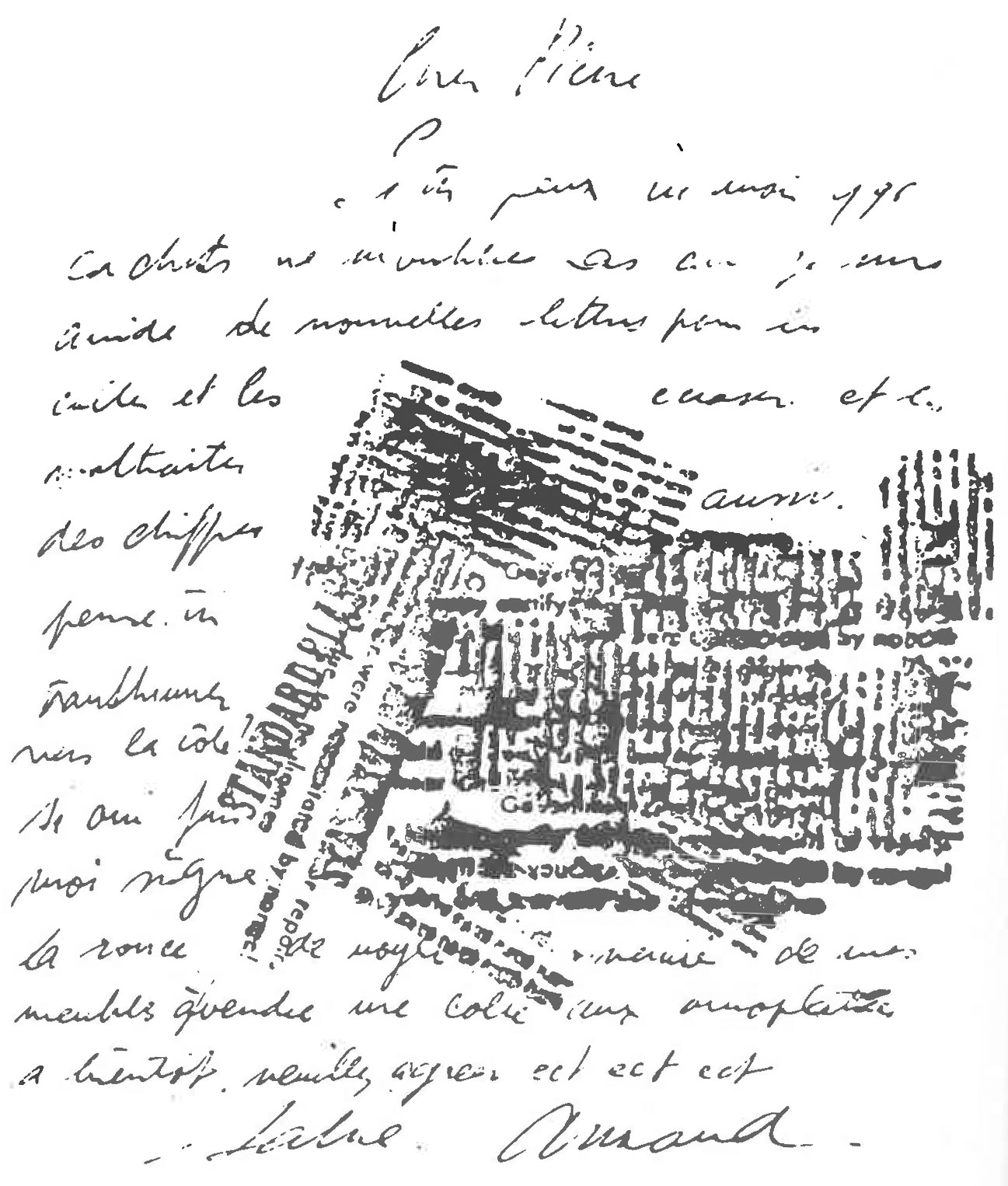
Arman, untitled, France, c. 1959. Letter to Pierre Restany with message built around multiple rubber stamp imprint.
The introduction of the stamp into contemporary art has been traced to 1949, when Ben Vautier used the stamp L’Art C’est in conjunction with a great number of works. The first major series of works composed basically of stamps were the mid-1950s projects of French artist Arman and German-bom artist Diter Rot. The late 1950s and early 1960s saw the systematic introduction of the stamp into projects by artists such as Joseph Beuys, George Brecht, Robert Filliou, Ken Friedman, Dick Higgins, Milan Knížák, Nam June Paik, Daniel Spoerri, Saul Steinberg, Timm Ulrichs, and Wolf Vostell. Allan Kaprow used stamps in the production of books and multiples. Emmett Williams used stamps to achieve a large number of his visual poems. Two groups of artists are almost exclusively prominent in stamp activity through the mid-1960s—nouveau réalistes, including Arman, Spoerri, Manzoni and Klein; the fluxus group, represented not only by individual members’ works, but by group-published stamp works such as Vautier’s Certification of Fluxart or Friedman’s Fluxpost Cancellation Mark.
In the middle and late 1960s, several well-known artists brought the use of the stamp into their work. These include Fletcher Copp, Jochen Gerz, Ray Johnson, Terry Reid and Andre Thomkins. The next groups to become identified with the use of the stamp were Ray Johnson’s New York Correspondance School and the Canadian Image Bank.
Prior to the worldwide explosion of rubber stamp art and its wide critical acceptance as an aesthetic medium, a group of artists emerged in the last years of the 1960s and the early 1970s who became identified as the first generation of rubber stamp artists to be particularly well known for their involvement with the stamp as a major rather than as a secondary activity. These artists include Hervé Fischer, J.H. Kocman, G. Pemeczy, and Peter van Beveren. Other artists of this period were known for other activities, but have assumed prominence in the area of stamping, including Dieter Albrecht, Charles Amirkhanian, John M. Armleder, Anna Banana, Dadaland (Bill Gaglione and Tim Mancusi), H.P. Huber, Hanns-Werner Kalkmann, Maurizio Nannucci, and G. J. de Rook. Large numbers of artists have also used stamps in their work in less systematic ways. These include Eric Andersen, Claus Boehmler, Felipe Ehrenberg, On Kawara, Piotr Kowolski, Les Levine, Panamerenko, Robert Rehfeldt, Jock Reynolds, and Bill Vazan.
II
The bibliographic history of rubber stamps may be said to begin with such publications as commercial catalogues, but the first book of rubber stamp works was the Sturmbilderbuch IV, executed by Kurt Schwitters in 1920. In contemporary art, rubber stamp books at their inception tended to be handmade single or limited edition publications, such as those made by Dick Higgins in the late 1950s. It is probable that a number of artists were making similar experiments at the same time. While it is likely that artists whom we do not discuss in this article have also made some published use of rubber stamps, the presentation here is limited to systematic work in which the stamp plays a significant part.
Of singular importance are two widely visible books which were made with the use of rubber stamps. Allan Kaprow set the text of his Assemblage, Environments and Happenings (New York, 1966) with rubber stamp type. Diter Rot’s Mundunculum (Hanover, 1967) is a literary and poetic work illustrated almost entirely with stamp drawings.
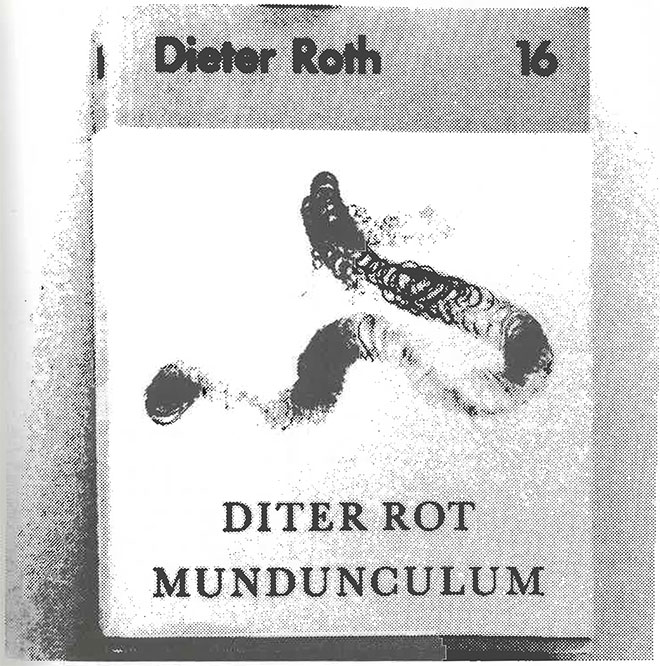
Diter Roth: Mundunculum, West Germany, 1975. Book with rubber stamp imagery.
By this time the first rubber stamp multiple had appeared, though it was not widely known or available. Emmett Williams’ 13 Variations on Gertrude Stein, released in 1965, was produced through the use of rubber stamps. In 1966, the first multiple to include rubber stamps as physical objects was published by fluxus in New York, the Fluxpost Kit containing stamps by Ken Friedman and Ben Vautier. One of the best known multiples in which stamps are presented as objects for use appeared in 1968 in Diter Rot’s Stempelkasten, published in Dusseldorf by Gerstner and Spoerri. The stamp as sculptural object was presented by Arman in the multiple Accumulation (1973). Arman had also used stamps as sculptural objects in earlier, singular works.
During the 1960s, most of the artists associated with the emergence of the stamp had used stamps in conjunction with published works, multiples, or in handmade rubber stamp editions. These included Beuys, Brecht, Filliou, Knizak, Machinas, Spoerri, Ulrichs and Vostell. By the end of the decade, the rubber stamp was respectable enough to have appeared in a mainstream New York multiple.
The project, Stamped Indelibly, was published in 1971 by Multiples, Inc., and included work by Red Grooms, Robert Indiana, Marisol, Qaus Oldenburg, Andy Warhol, Tom Wesselmann and others. One series of rubber stamp works was widely visible during the entire decade—the witty cartoons and drawings of Saul Steinberg, many of which appeared in the New Yorker.
By 1971, critical reception of rubber stamp activity had begun. Jean-Marc Poinsot, who had organized the communications art section of the Seventh Biennale of Paris, released his book Mail Art: Communication, a Distance Concept (Editions C.E.D.I.C., Paris). Poinsot’s book does not deal specifically with the rubber stamp, but because of the stamp activity in which so many of the artists included in the book engaged, the rubber stamp is prominently portrayed in the works illustrated in the text.
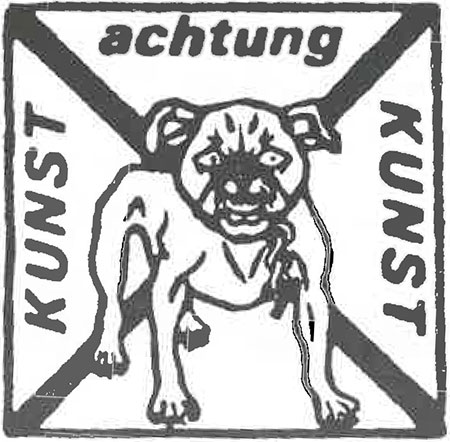
Rubber stamp by Rolf Staeck.
The first true anthology of stamps and their use by artists was the book Stamp Activity published by Czech artist J.H. Kocman in 1972. The book is an extremely rare limited edition of thirty copies, including the work of twenty-five artists, both early figures in the medium and others who had become major new figures in the medium. Kocman’s anthology is a beautifully produced book printed directly from the original rubber stamps, bound and presented in the finest tradition of Eastern European “samizdat” (“Selbstverlag” or “handmade”) publishing. Kocman’s book is of great historical and aesthetic importance. It is the first anthology to present stamp activity, sui generis, as a significant development in the fine arts.
In 1973, Ken Friedman produced a large rubber stamped narrative text. The book was published by Henrik Have, the Danish publisher of Edition After Hand, entitled A Ready Hand Novel.
In late 1973, the first critical documentary on the use of rubber stamps in art appeared as a radio program on station KPFA of Berkeley, California, organized, produced and directed by Charles Amirkhanian—a poet who is also recognized for his stamp activity. The program included a tour of the H.R. Ellis Rubber Stamp Company of Berkeley, California, and a lengthy discussion with Ken Friedman. The program was heralded in the KPFA Folio with a suite of rubber stamp drawings executed by Bay Area printmaker Carol Law, using stamps made by the Ellis Company and stamps borrowed from the Fluxus West stamp museum.
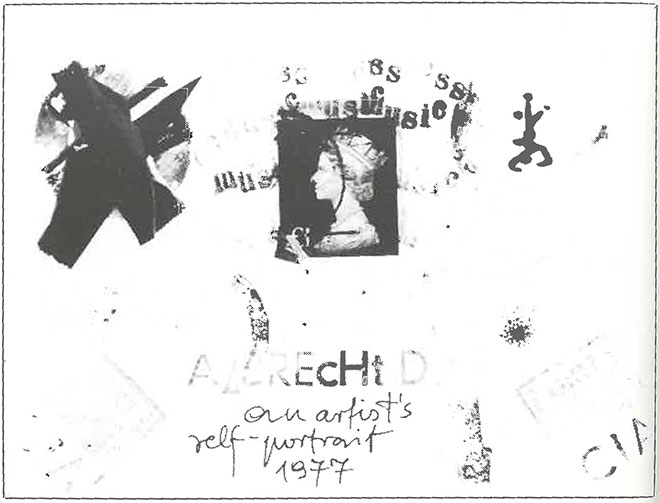
Albrecht D., Self-Portrait, West Germany, 1977. Collage postcard.
1974 saw the publication of the first attempted encyclopedia of rubber stamp work, Hervé Fischer’s Art et Communication Marginale, Tampons d’Artistes. Fischer’s book is the most widely available publication in the field. Aimed at a large audience through an introduction published in three languages, Fischer attempts to present an overview of stamp activity along with a large number of stamp artists and their work.
The 14-page introduction contains a mass of information in formally descriptive categories. Fischer deals with twelve categories, which he lists as:
Theme of Communication
Counterinstitutions
Protest
Various Statements of Values
Numbering
Certifications
Appropriations
Prints
Science
Visual Poetry
Works of Art
Playful Activity
In each of these categories, Fischer lists a number of artists and representative works.
The first substantial historical account of stamp activity was written by Timm Ulrichs, one of the major German artists known for the use of the rubber stamp. In an article entitled “Stempel, zur Kunst gestempelt” and sub-titled “Kommunikations—mittel par excellance” (Magazin Kunst, V. 15 (1), 1975) Ulrichs provides history, etymology, and a discussion of related phenomena such as daktyloscopy. These are followed by a chronology of his own stamp activities in an extensive illustrated account. Ulrichs singles out as the pioneers of stamp art Kurt Schwitters and Diter Rot. Regretfully, he ignores Arman. His attitudes toward stamping can be described as an attempt to democratize the arts and to militate against “elitare Druckmittel” (the elitist means of printed communication). For Ulrichs, the rubber stamp is a means of communication suited to the use of wide varieties of people, artist and non-artist alike. One wishes that Ulrichs had been given the space to treat the work of other significant contemporary artists involved in stamp activity as brilliantly as he presents his own work. With a thorough and systematic approach, Ulrichs offers one of the clearly exemplary articles in the area of the rubber stamp.
More recent anthologies of rubber stamp activity include projects by de Rook, Ecart publications, and the University of Colorado at Colorado Springs, often the catalogues of projects or exhibitions. One of the most beautiful of these is the Stempelboek organized by Jan Brand and Peter van Beveren (Middleburg, Netherlands, 1975).
A special area of rubber stamp publishing is the unique self-published edition. As we noted, Dick Higgins’ earliest stamp works took this form. Many other artists have made such publications, including Imre Bak, Gary Lee-Nova, and Jiří Valoch. A specific form of this work is the “archive” or “monograph” comprised of whole collections of the stamps used by artists. Various forms include single stamps, stamps in sequence, or stamps used in a series of pages, as well as stamps presented in some of the contexts in which they appear elsewhere. Friedman’s Rubber Stamp Archive, produced in various forms since 1966, now fills several large volumes totaling over 1500 pages. Kocman’s Monography of My Stamp Activity is a single volume released in 1974. Other such monographs have been similarly produced under less well defined circumstances by John M. Armleder, Jiří Valoch and Dadaland. A characteristic feature of these publications is that while the stamps themselves are used and shown widely, the monographs or archives are usually produced and shared only with other artists, frequently in trade for similar works. To a lesser degree, they are sold as special items to collectors or institutions.
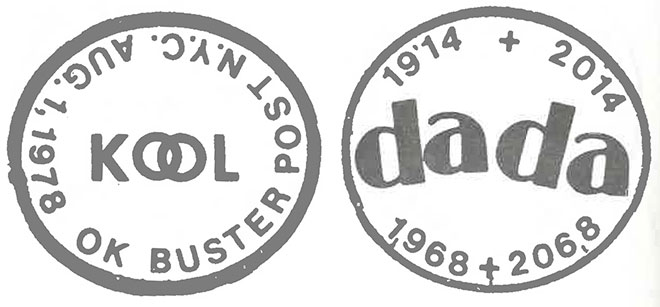
Rubber stamps by Buster Cleveland.
III
In order to comprehend the vitality and meaning of the stamp phenomenon, it is necessary to structure a framework which deals with the stamp in several ways. One needs to account for the phenomenon:
- Historically, both prior to and since the introduction of the stamp into art;
- Aesthetically, as an arena for significant art activity;
- Through the vehicle of a sociology of the arts, as a human activity within the arts;
- In the wider sociological context which places the stamp and stamp art in the framework of society as a whole.
Fischer attempts to do this in the partial manner we have discussed. Schwarz- bauer organizes the phenomenon into a limited typology comprised of five major categories:
Stamps with informative messages or references,
Stamps advertising their own existence,
Stamps as pure action,
Stamps as postal objects.
Stamps as artificial products.
Schwarzbauer himself points out that his typology is neither full nor entirely useful, but states clearly that an adequate understanding of this multi-faceted phenomenon must eventually rest upon a substantial typology. Ulrichs creates a form of typology in his contribution, but this typology largely derives from history and the functional precedents of the contemporary stamp, rather than being based on the aspects of contemporary form and usage.
In order to create a comprehensive structural typology of stamps, it is necessary to account for all of these factors. The subtly interwoven strands of history, meaning, form and function—so closely overlapped as they often are—require a structure which is both delicately balanced and open enough to account for the entirety of the field. Such a structural typology presents difficult and elaborate problems, but remains the goal of research in the area of the stamp.
IV
In discussing contemporary stamp activity, a brief look at the history of the stamp sheds light on some of the implications bound up in the phenomenon of stamping. The earliest forms of stamping, such as cuneiform and signets, were acts of communication. This fact is common to all stamp activity since that time. Of particular interest is the political implication of early stamps. Communication, the hiring of scribes, and the possession of signatures and individuating marks were the province of the aristocratic classes. In a limited way, this aspect of communication is still evident in many nations where only the privileged classes have access to communications media, whether by legislative action and censorship or by economic control. In the stamp, this phenomenon was presented by Beke Laszlo in his unrealized stamp project, “Je n’ai pas de tampons, parce-que en Hongrie, il n’est pas permis de faire tampons par personnes prives.” (“I have no stamps because in Hungary, unauthorized persons are not allowed to make stamps, or to have stamps made for them.”)
Other early implications still invoked by the stamp revolve around the identification of ownership and production. Even though the use of the stamp gradually expanded, a relatively small class of privileged individuals—those who owned, or those who produced—made use of stamps and marks. This usage still survives today, though paradoxically expanded to the use of millions. It is the advent of mass technology which today makes possible the situation toward which Ulrichs and others point: that the stamp has become a medium available to and truly useful by the people, a reversal of the earliest context of the stamp.
The introduction of aesthetic and philosophical content into the stamp arrives with medieval woodcuts and Renaissance emblemata. The advent of the stamp composed of rubber coincides with industrialization, mechanical reproduction and the rise of the modern nation state. Rubber was introduced to the western world during the Spanish conquest of the Americas in the 16th century. Rubber was first produced commercially in a Viennese factory established in 1811. We see the bureaucratic use of the rubber stamp prefigured in the discovery of rubber by a colonial power and its production within the framework of the industrial system.
The first uses of the rubber stamp took place within the bureaucratic and commercial contexts. Stamps were used to validate and to certify documents. No human activity in modern times is possible without the intervention of bureaucracy, and its arm, the stamp. The stamp proves on the birth certificate that one is indeed among the living. The stamp validates on the marriage license the union of woman and man: what God and the stamp have joined together, let none tear asunder ... until, of course, divorce proceedings take place, certified on papers marked with one form or another of the stamp. Whenever we pass from one realm to another, whether from nation to nation or life to death, stamped impressions on the passport or death certificate bear witness to our departure. It may be noted that not all of these stamps or seals are composed of rubber, but since the rubber stamp came into wide production, the vast majority of certifying seals formerly created by various embossing devices have been rubber stamps. The continuing parallel between rubber stamps and commerce in mass society is reinforced by the fact that only rubber stamps can be made swiftly enough and in large enough quantities to certify and channel the vast amounts of paperwork involved in all aspects of the contemporary world. Stamps not only give value . .. they devalue. Stamps are used in the postal system to remove the franking privilege embodied in the frank-mark, most commonly through the cancellation of the postage stamp. In commerce, stamps may not give value or remove it: they may simply indicate value or facilitate a commercial transaction through numbering, pricing, or the identification of individuals and products.
Stamps first came into the hands of the common man in the form of personal name and address stamps. Where the past, functional history of the stamp ends and the contemporary history of the stamp begins is the arrival of rubber stamps used by the wide public. The availability of the rubber stamp gave to some unknown genius the idea of using a stamp to convey a slogan or message, probably political or commercial. In a certain sense, this gesture was the grandparent of contemporary stamp art.
Whoever the grandparent of rubber stamp art may have been, we know the name of the father: Kurt Schwitters. At the time that the principle of the ready-made was introduced to art by Marcel Duchamp and Man Ray, Kurt Schwitters found in the stamp another ready-made vehicle for art activity. This fertile period in the history of art is typified by the act of transformation (Duchamp’s theory of displacement). Just as during those years and since, art moved forward by the introduction into the art context of phenomena previously belonging to the world at large, Schwitters spawned a new art medium by transforming the rubber stamp into a tool for drawing and collages. As early as 1919, Schwitters produced rubber stamp drawings and included stamps in his collages. In 1919, only one artist used rubber stamps. Today—over half a century later—thousands of individuals in the arts use rubber stamps in conjunction with, or as a major feature of, their work.
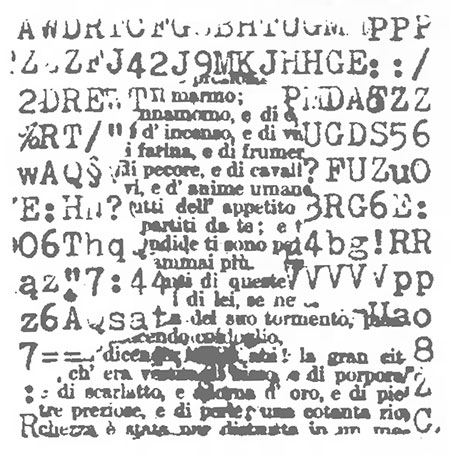
Rubber stamp by Piotr Rypson.
V
We have already referred to Fischer’s concept of “interrogative teaching” implicit in this specific art form. We also quoted Timm Ulrichs’ understanding that rubber stamps used by artists have a “subversive” character, a clear political dimension. Very few critics so far have been able to treat “experimental art,” which really is not marginal once one is willing to take it as a serious manifestation, systematically and in its proper framework. But one critic ought to be mentioned, although he does not discuss rubber stamp activity. Instead, he specifically addresses himself to the phenomenon of easy reproducibility and impact on the art scene. Walter Benjamin, in his still unsurpassed Das Kunstwerk im Zeitalter seiner technischen Reproduzierbarkeit (The Work of Art in the Age of Mechanical Reproduction, translated by Hannah Arendt) has formulated a theory of art where decreasing aural qualities of art are to be related to increasing reproducibility, which has to be seen as connected with increasing politicization. Benjamin says:
Theses about the developmental tendencies of art under present conditions of production . .. brush aside a number of outmoded concepts such as creativity and genius, eternal value and mystery—concepts whose uncontrolled (and at present almost uncontrollable) application would lead to a processing of data in the Fascist sense. The concepts which are introduced into the theory of art in what follows differ from the more familiar terms in that they are completely useless for the purposes of Fascism. They are, on the other hand, useful for the formulation of revolutionary demands in the politics of art.
This was written in 1936 and has not lost any of its value. If we want to have an art which can relate to larger pans of society, it is imperative to rethink the concepts of aura, genius, autonomy, and authenticity. Art which counts only on its intrinsic merit sides with a system which it ought to subvert. He who insists on the concept of art derivative of the aesthetics of purposeful purposelessness commits societal suicide. “Fiat ars, pereat mundus,” as Benjamin paraphrases the insistence of “pure” artistic beauty. Mass media, reproduction, and mass participation, are the new criteria which help to relate art to society. Walter Benjamin did not know concept art, mail art, underground films, happenings, performance art, video. Nor did he know the phenomenon of the artists’ stamp. But he had a keen eye for the past and the present, as well as for the future. After all he grew up with photography, film, dada, surrealism, and the epic theater of Bertolt Brecht. It is, therefore, hardly surprising that we find in Benjamin and Brecht, rather than in Marxists such as Lukacs, seminal statements for a politically relevant theory of art in the age of technology. Any art which wants to be taken seriously will have to militate against commodification of “monétarisation” (as Marcel Duchamp called it). Reproduction, particularly in the form of film, video, and the rubber stamp, is ideally suited to destroy the aura attached too often to the work of art. Benjamin put it this way: “But the instant the criterion of authenticity ceases to be applicable to artistic production, the total function of art is reversed. Instead of being based on ritual, it begins to be based on another practice—politics.”
It is precisely this aura which has led to commodification. Art should not only be reproduction (mimesis, reflection) of a given society, it should also be production of a new consciousness. Most frequently this production of a new consciousness is done with new media which are often—at the beginning—“marginal” to the creative process: film, video, rubber stamps. What Harold Rosenberg once said about the media in relation to art, generally applies fully to the phenomenon of the rubber stamp: “The media turn art into media—art retaliates by turning media products into art.” The rubber stamp has always been the powerful arm of authority. This is inherent in the etymology of the word in various languages. To stamp is a powerful movement of the foot. The Greek word sphragis refers to words such as “to seal, to shut up, to seal as stamp with approval.” It can also be translated as “to limit, to define, to determine,” all words with authoritative connotations. The German language has developed a most interesting metamorphosis of the term in the statement “stempeln gehen,” to go to the welfare or unemployment office to be certified to receive a minimal amount of money to guarantee basic survival. Literally, it means “to go and get a stamp,” to be able to prolong life. It is certainly no coincidence that the only way to subvert the authoritarian use of the rubber stamp was to use it in the context of art. We are aware, of course, that by introducing exhibition value to such a phenomenon as the rubber stamp, which essentially militates against aural and exhibitional commodification, these stamps are increasingly regaining an aural quality. But this is a phenomenon which is unavoidable until art is redefined totally. Duchamp tried this by playing chess instead of making art. Beuys, more and more, discusses art in a political context rather than making art. In this sense, Benjamin again predicted accurately: “One of the foremost tasks of art has always been the creation of a demand which could be fully satisfied only later.” For the time being, the task of art is to destroy the artificial boundary lines between life and art.
VI
We have offered this brief study on the stamp and stamp art as an introduction to the stamp exhibition organized by the LA MAMELLE ARTS CENTER in San Francisco. The history of the stamp prior to the rubber stamp, and the history of the rubber stamp prior to its inclusion in art, shed light on the meanings and implications of the stamp in an art context. The wide variety of stamps and stamp activities created by artists since Schwitters’ seminal work early in this century are reflected in our brief bibliography, and can be studied further through its use. The study of the stamp, particularly the rubber stamp, and its use by artists has grown in interest and significance over the last decade. When Schwitters’ stamp activity began over a half a century ago, he was unique. With the growing use of the stamp by artists launched in the mid-50s by Arman and Dieter Rot, and carried forward by a small significant group of artists through the 60s, the rubber stamp became a medium of interest to historians and critics concerned with contemporary art. Today, the use of the stamp by artists has blossomed into a major international phenomenon.
Thousands of artists are now involved in stamp activity. The stamp is used as a tool for drawing and sculpture, as a medium for publishing and printmaking, as an educational device in the teaching of design and poetry, and as artistic subvention of politics. The stamp is used by the most famous artists and the least known. Important works are created with stamps as well as inconsequential and mediocre productions ... just as with any medium. Unlike other media, however, which have had the benefit of proper exploration and the development of a substantial critical framework for future study, the stamp is still somewhat neglect. Like any other medium, the stamp offers a large and significant opportunity to the creative human being involved in the arts. The study of stamp activity will reveal work of all sorts and qualities. As the study of any medium must, particularly the study of a medium still in its developmental stages, research into stamp activity will shed valuable light on human activity as reflected in the fascinating area of the arts.
